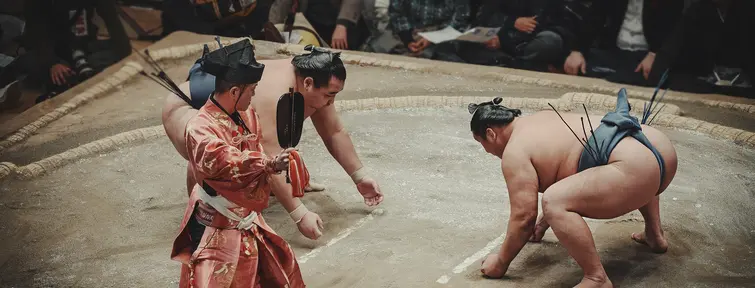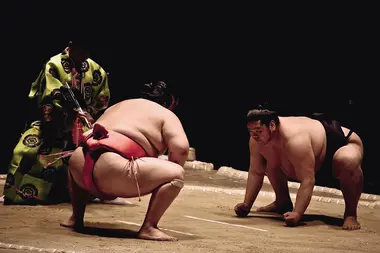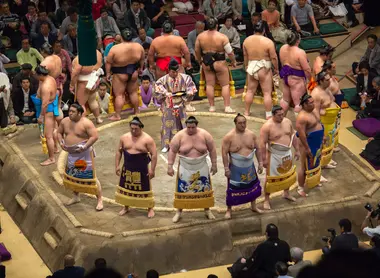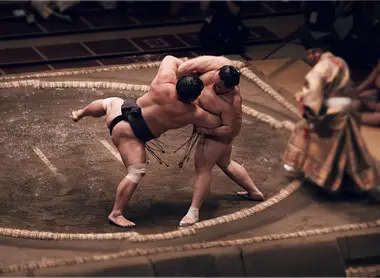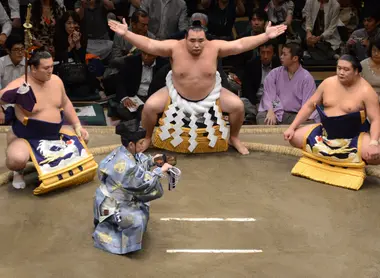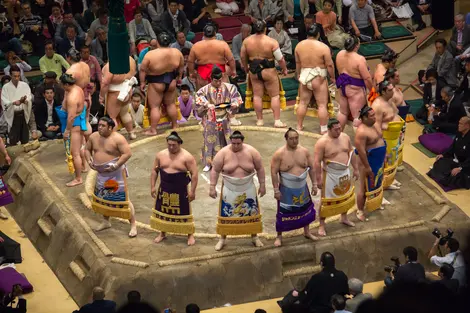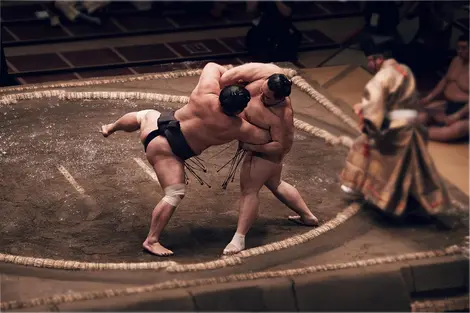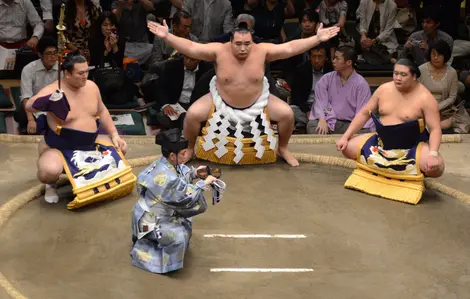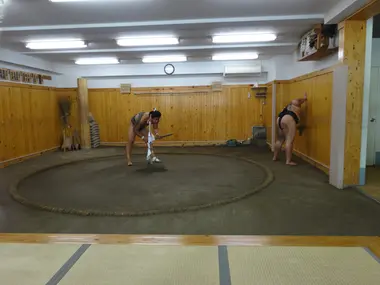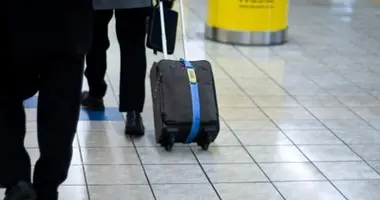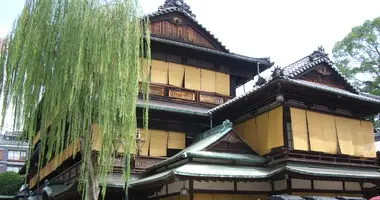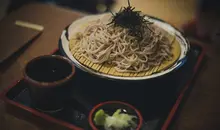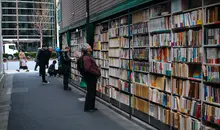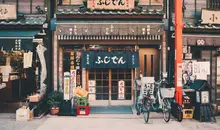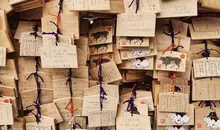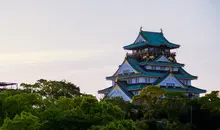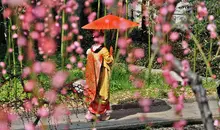Sumo tournament in Japan: a guide to watching the matches
- Published on : 01/01/2025
- by : G.L.
- Youtube
Sumo, Japan's national sport, is one of the world's most emblematic martial arts. Immediately recognizable, it is synonymous with Japanese culture and, for many, seeing sumo in action is a dream come true. But what exactly can you expect when you attend a sumo tournament? Read on for more information on this topic and on the sport as a whole!
Today, there are an estimated 180 different martial arts practiced around the world. While each of these martial arts has a distinct history linked to its culture of origin, their practices are increasingly establishing themselves on the international stage, embraced by dynamic athletes and fighters from all over the world. This rationalization is a recognition of the respective growth and development of these martial arts, but for sumo, the image of large-bodied fighters clashing in a rustic ring on a dirt floor is a Japanese image in its own right.
This is also evident in the details and iconography of historic Japan found throughout the sport, and without them, sumo can hardly be considered as such.
Considered Japan's national sport, this martial art has a centuries-long history and is firmly rooted in Shinto customs. From the purification of the ring with salt to the solemn stomping of the wrestlers to chase away evil spirits, the ceremonial procedures reflect the timeless spiritual value of this captivating spectacle. Sumo matches offer a unique opportunity to experience Japan's cultural heritage and competitive spirit in a sustainable environment.
The rich history of sumo (spelled 相撲 in Japanese) comes to life when you attend a sumo tournament in Japan. It's an immersive experience that's sure to make a trip to the island nation even more authentic and unique. But what does it involve to take part in one of Japan's most popular cultural activities?
In this article, we will review some of the key details of the sport of sumo and the process of participating in a tournament:
- the basic rules of sumo
- Tournament procedure
- Ticket acquisition
- General information you need to know!
Read on for useful information before attending one of Japan's most significant cultural events, and enjoy the atmosphere fueled by tradition and competition!
What you need to know about sumo
Sumo is defined as a wrestling sport, and its dynamism and appeal lie in its simplicity. Essentially, two wrestlers, called rikishi, go head-to-head to put the other out of their misery, using a variety of gripping, sliding and other techniques. To maintain their balance and stature, greater weight and center of gravity are largely beneficial, which explains why sumo wrestlers are built to have very large and heavy bodies. Here's a clearer overview of the general rules and what disqualifies a fighter during a match:
The basic rules
1. Using authorized techniques, rikishi seek to make their opponent leave the ring (known as the dohyo) or touch the ground with something other than the soles of their feet.
2. Permitted techniques include such things as pushing, grabbing, slapping and stumbling. Prohibited techniques include
- punching
- Kicking
- Grabbing below the waist
- Hair pulling
- Hari-te (full-motion slap)
- Choking
- Sabaori (strike from above while holding belt)
- Locking the fingers in a "prayer" type hold during a fight.
3. A sumo match is led by a figurehead called a gyoji.
4. The ring is surrounded by five shinpans who serve as secondary judges and are all former rikishi fighters themselves.
Indeed, the rules are very simple, and therein lies much of the sport's charm: the emphasis and appreciation of the "critical moment", in which a match is decided in a single move at a given moment. In official sumo, a match consists of three rounds.
Sumo culture
As already mentioned, sumo is a sport steeped in tradition, thanks in large part to the long history of its development in the island nation. This is evident in elements such as the dohyo ring, rebuilt by hand before each tournament. The outer edge of the dohyo is made of braided rope, called shimenawa, which is a traditional Shinto ornament! In many Shinto shrines in Japan, visitors will see shimenawa ropes hanging from the main structure and in other places, and their presence in sumo bears witness to the deep ties that bind the sport to Japan.
As with many other sports, training and development begin at a relatively young age. Many rikishi begin their journey in junior high school, rising through the ranks as they mature and gain experience. There are around 600 rikishi training and competing in Japan. The vast majority of these rikishi, throughout their training and careers, live in accommodation known as "sumo stables". In these stables, the rikishi are housed and fed, and in the mornings they train and practice.
These stables are often located in the districts of the respective cities that are established centers for sumo wrestling. In Tokyo, this is Ryogoku, located in the city's Sumida district.
Ryogoku is home to the Kokugikan, Tokyo's sumo tournament stadium, and most of the city's sumo stables are located nearby. In fact, rikishi and sumo trainees are often present in the neighborhood.
Today's Ryogku Kokugikan bears the same name as a stadium opened in 1909. This building eventually closed and the new one was inaugurated in 1985. Although the facility hosts a number of different events, including boxing matches and other sporting fixtures, it is best known for sumo.
Tournament season
Sumo competitions take place mainly during the tournament season, of which there are three a year, in January, May and September. The tournament runs for two weeks during these months, and around 70 established rishiki compete each day, with other competitors having matches every other day.
The rikishi rankings are published well in advance of the tournament. There are six different competitive divisions in sumo, the top 42 being part of a division known as Makuchi. It's the rikishi who attract the most attention and fanfare, but attending a series of matches is a serious event with plenty of sparkle.

Inside the Kokugikan in Ryogoku
@Japan Experience
Experience sumo in depth
The excitement and dynamic environment of a sporting event combined with the historical culture of sumo make participation in a sumo tournament one of themost memorable events a traveler can experience. Of course, there's so much to learn that watching isn't the only option for immersing yourself in sumo culture! A visit to the sumo stables in the morning to watch their morning training allows you to peek behind the curtain of their training, in a more stripped-down and intimate atmosphere. Discover their exercise routine and witness the unique environment of a morning training session, where an eerie silence reigns due to the tension of concentration. Visiting the sumo hall in the morning and seeing the results of their training at the tournament is a unique experience!
Learn more about sumo by visiting the training stables in the morning!
Attend a tournament in Japan
Attending a tournament in Japan is a dream activity for many travelers, as a sumo event of this magnitude is reserved for people living in or visiting the country. If you have the opportunity to take part in the festivities of a sumo tournament, there are a few points to note and prepare for!
First of all, it's worth noting that the tournament lasts all day. This doesn't mean that you're obliged to enter at the start and stay until the end, but the matches take place throughout the day. If you stay all day, you'll notice that the hall gradually fills up as the most popular and well-known fighters have their matches later in the day. Staying all day allows participants to enjoy the unique environment, and as the top fighters take to the stage, the ceremonies and ornamentation of their outfits and rituals become more prestigious and extravagant.
In the stadium, it's possible to buy bento boxes for lunch, many of which feature specialized motifs of popular rikishi. By 12 o'clock, many participants are eating, giving the venue a communal, picnic-like feel! These bentos are designed to be eaten at your seat.
Most sumo venues feature standard stadium seating, as well as more traditional boxes with cushions for spectators. There are usually four people per box, and they are often reserved by groups of this number.
The seats encircle the central dohyo, and there is a concentrated but eerie silence in the arena before and during matches, but as soon as a match begins, the vigorous growls of the two wrestlers clashing echo throughout the stadium. Above the dohyo and seats, photos of champions from previous tournaments are displayed, as well as those of the venerable Yokozuna, the most revered rikishi in history who only earned the title after winning at least two consecutive tournaments.
Of course, as with any sporting event, there's no shortage of merchandise at a sumo tournament, ready to be purchased by dedicated fans. General merchandise is available, but rikishi-specific items are also on sale!
Getting tickets for a sumo tournament
Of course, to attend a sumo tournament, you'll need to get tickets for the event! In Japan, sumo, the national sport, is very popular. So tickets are in high demand, especially as the tournaments only take place three times a year!
There are two main ways of obtaining tickets: in person at a Ticket Pia office in Japan, or via the Ticket Oosumo website (also operated by Ticket Pia). The Japan Sumo Association announces the ticket purchasing period well in advance, and on the night before it goes on sale, many fans line up at Ticket Pia stores for the best chance of getting quality seats. For those who choose this route, be prepared to queue. For sumo in particular, Ticket Pia store staff will hand out cards to be filled in with information about the purchase and disposition of the desired seats.
Ticket Oosumo is considered a more reliable and simpler way to buy tickets, but be aware that even on this site, tickets are in high demand. Tickets on this site can be purchased in English and are collected on the day of the performance.
Essentially, tickets are distributed according to seating, classified as follows:
- Ring-side seats: These are the seats closest to the dohyo and cost 20,000 yen each. They are exclusive to the Ticket Oosumo site.
- Box seats: These are enclosed boxes in which groups of four can sit, and are rented at a general rate that can be divided between each participant. They are graded from S to C, with S being the most luxurious and closest loges.
- Armchairs: These look like typical stadium seats and are the furthest from the dohyo, but they're the most affordable and still offer a good view of the action!
Seat prices vary for weekday and weekend tournaments, and are subject to change from year to year. In 2025, box and stadium prices are as follows:
| Seat rank | Seating (weekends/weekends) | Seating (weekends/weekends) |
|---|---|---|
| S | 60,000 yen/50,000 yen | 9,500 yen/9,000 yen |
| A | 52,000 yen/48,000 yen | 8,500 yen/8,000 yen |
| B | 42,000 yen/40,000 yen | 5,500 yen/5,000 yen |
| C | 38,000 yen/34,000 yen | 4,000 yen/3,500 yen |
